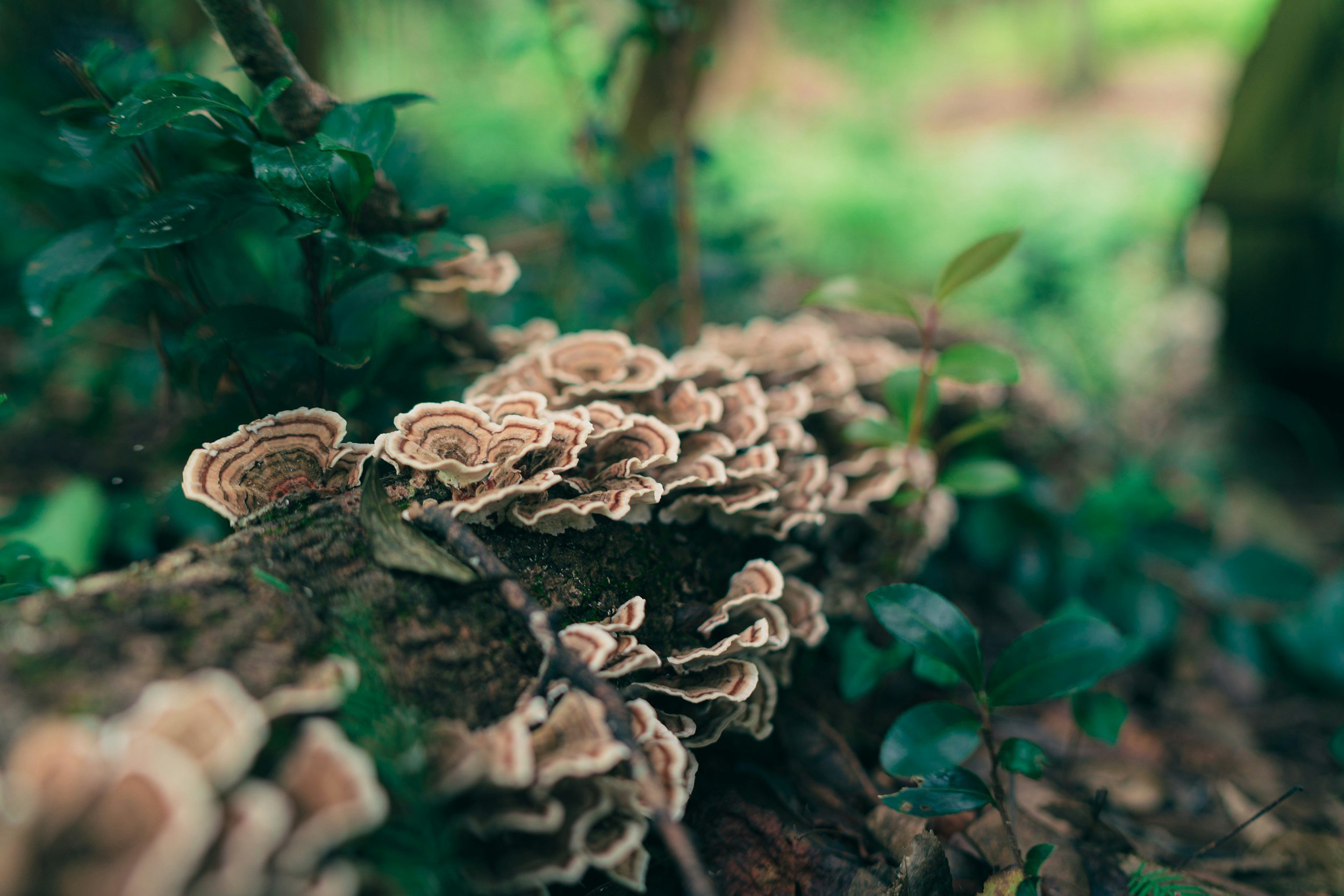
Turkey Tail
Turkey Tail
(Trametes versicolor)
Turkey Tail (Trametes versicolor) is a thin, leathery bracket fungus that grows in overlapping fans on dead or dying hardwood. Its cap shows distinctive concentric bands (often brown, grey, cream, and sometimes green due to algal growth), and it can be found in the UK year-round, especially in autumn and winter.
In East Asia, Turkey Tail is known in Traditional Chinese practice as Yun Zhi and has a long history of traditional use, commonly prepared as a decoction. Modern interest has focused on its chemistry (especially polysaccharides), but this page is provided for education and identification rather than medical advice.
Plant family:
Polyporaceae.
Parts used:
Fruiting body.
Typical forms of prescription:
Decoctions.
Decocted tinctures.
Powders.
Dosage:
Decoction: 9-15g pd
UK note: In Great Britain, foods classed as “novel foods” must be authorised before they can be sold. The ASA has stated that Turkey Tail (Trametes versicolor) is likely considered an unauthorised novel food (per the FSA position), so products containing it should not be sold in the UK unless appropriately authorised. The authorisation process can be complex for the “smaller” producers.
Foraging for Turkey Tail for personal use, with landowner permission and respecting local bylaws/protected sites. See my Herbal Foundations page for general herbal preparation methods, for educational purposes, of course.
Turkey Tail (Trametes versicolor) - Clinical Snapshot
Has been studied for:
Primary Actions:
Anti-inflammatory
Immunomodulator
Analgesic
Antimicrobial
Antinociceptive (reduces pain sensitivity)
Chemoprotective
Hepatoprotective
Supports lipid balance (hyperlipidaemia)
Primary Indications:
Immune system support
Supportive care in chronic illnesses such as:
Diabetes
Hepatitis
Adjuvant therapy during chemotherapy or radiotherapy
⚠️Cautions / Safety⚠️
None known
Trametes versicolor
Phytochemistry and Pharmacology
-
Action: Immunomodulating, anticancer, antiviral
Use: PSK is a protein-bound polysaccharide found predominantly in Japanese strains. It enhances T-cell and NK-cell activity, modulates cytokine response, and is widely used as an adjunct in cancer therapies (especially gastric, colorectal, and breast cancer). PSK is also antiviral, particularly in chronic viral infections (e.g., HPV, hepatitis).
-
Action: Immunomodulating, hepatoprotective, antiviral
Use: PSP is similar to PSK but sourced from Chinese strains. It enhances immune cell communication, supports the liver, and contributes to antiviral and antioxidant effects. PSP is commonly used in chronic infections, fatigue, and cancer recovery support.
-
Action: Immune-stimulating, prebiotic, anti-inflammatory
Use: These complex polysaccharides activate macrophages, dendritic cells, and NK cells, helping the body recognise and respond to pathogens or abnormal cells. They also have prebiotic activity, supporting a healthy gut microbiome, a key aspect of immune function.
-
Includes: Sterols, lanostane-type triterpenes
Action: Antiviral, anti-inflammatory, hepatoprotective
Use: These compounds contribute to liver support, help regulate inflammation, and may assist in the management of chronic infections or inflammatory conditions.
-
Includes: Protocatechuic acid, caffeic acid
Action: Antioxidant, anti-inflammatory
Use: These add to the free radical-scavenging and tissue-protective actions of Turkey Tail, especially valuable in chronic illness, immune depletion, or cancer recovery.
Traditional Use
While there is no recorded traditional use of Turkey Tail in the UK, it has a long-standing role in Traditional Chinese Medicine (TCM), where it is used to strengthen the Qi of the heart and spleen, support those with fatigue or general weakness, and assist in slowing tumour growth. In Japanese Kampo medicine, it has also been used for similar purposes, particularly in the recovery from chronic illness.
Clinical Discussion
In Western Herbal Medicine (WHM), Turkey Tail is increasingly valued for its ability to modulate the immune system, supporting underactive and overactive immune states. It’s commonly taken as a powdered extract, decoction, or brewed into immune-supportive teas and broths.
Its key medicinal constituents are polysaccharopeptides, notably PSK (polysaccharide-K) and PSP (polysaccharide peptide). These compounds have been shown to stimulate immune cell activity, including the production of cytokines and chemokines like TNF-α, IL-1β, and IL-6, which play essential roles in immune response and inflammation regulation.
Turkey Tail has been widely used in integrative cancer care in China and Japan, especially as an adjuvant to chemotherapy and radiotherapy. Its ability to support white blood cell production and bolster resilience during treatment is well documented in clinical settings overseas, though it has only been acknowledged more recently in Western practice.
Cultivation and Harvesting
Turkey Tail is a common bracket fungus that grows on dead or decaying hardwood, especially oak and beech, in moist, shaded woodlands. It can be cultivated on logs or sawdust using mushroom plug spawn. Fruiting may take 6–18 months and requires humidity and shade. Harvest the fresh, pliable brackets when fully formed, typically in autumn, then dry thoroughly before storing. Always ensure correct identification, as similar non-medicinal fungi exist.
Key Botanical Features of Turkey Tail (Trametes versicolor)
Growth
Trametes versicolor is a common polypore mushroom found on decaying hardwood.
It grows in layered, fan-shaped rosettes or semi-circular shelves.
Individual caps typically measure 2–8 cm in diameter and 1–3 mm in thickness.
It lacks a central stalk and is instead attached laterally to the wood.
Flesh is thin, leathery, and flexible when fresh, becoming tough and papery when dry.
Mycelium & Substrate
Forms a dense, spreading network of white mycelium within rotting wood.
Prefers fallen logs, stumps, and dead deciduous trees (especially oak and beech).
It plays a key ecological role in decomposing lignin and cellulose in wood.
Usually found in temperate forests, especially in damp, shaded areas.
True vs “False” Turkey Tail (UK ID)
True Turkey Tail: Trametes versicolor
Underside (key feature): a pore surface (not smooth), described as white–cream (often buffing with age), with pores ~3–5 per mm and tubes < 3 mm deep. (Buczacki et al., 2013)
Growth habit: thin, bracket-like caps that often form densely overlapping tiers on broad-leaved wood (white-rot). (Buczacki et al., 2013)
“False Turkey Tail”, usually Stereum spp. (e.g., Stereum hirsutum)
Underside (key feature): smooth / non-poroid (no visible pores).
Edibility/toxicity note: generally regarded as non-toxic but inedible/tough, and it’s not the same fungus discussed in most Turkey Tail tradition/research. Does not contain the same medicinal values as Trametes versicolor (Bergamin, 2025).
Cap (Fruiting Body)
Shape: Fan- or semicircle-shaped brackets.
Surface: Velvety to finely hairy with distinct concentric zones.
Colour: Highly variable, shades of brown, grey, white, tan, orange, or blue.
Zoning: Concentric bands of varying colour give a striped appearance, like a turkey’s tail feathers.
Edge: Often wavy or slightly lobed, with a whitish margin when young.
Underside (Pore Surface)
Type: Polypore (no gills, spores are released through pores).
Pores: Tiny, round, and densely packed (3–8 pores per mm).
Colour: White to cream; does not bruise easily.
The surface remains firm and unchanged upon touch.
Spores
Spore print: White.
Shape: Cylindrical to slightly curved.
Released from the pore surface on the underside of the cap.
Adaptations
Extremely tough and resistant to decay, it can persist on wood for months.
Thrives in moist, shaded woodlands but tolerates a range of conditions.
Plays a vital role in nutrient cycling by breaking down wood tissue.
Rarely parasitic; primarily saprophytic (feeds on dead organic matter).
Sustainability/conservation
Common and widespread across the UK and temperate regions worldwide.
It can be foraged sustainably if small amounts are taken from abundant patches.
Often cultivated commercially for medicinal extracts (beta-glucans, PSK, PSP).
Ensure correct ID, many lookalikes exist in the Trametes and Stereum genera.
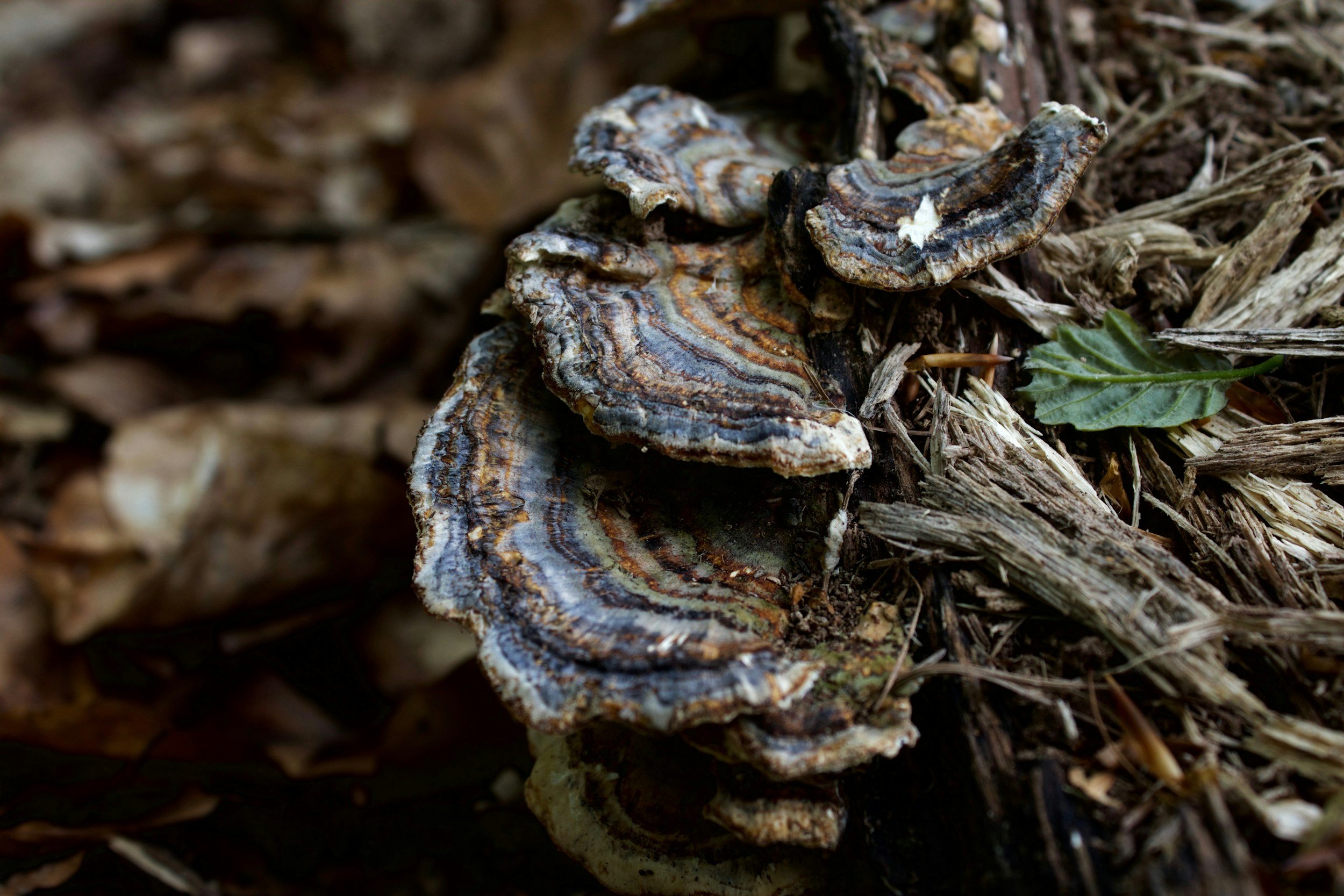
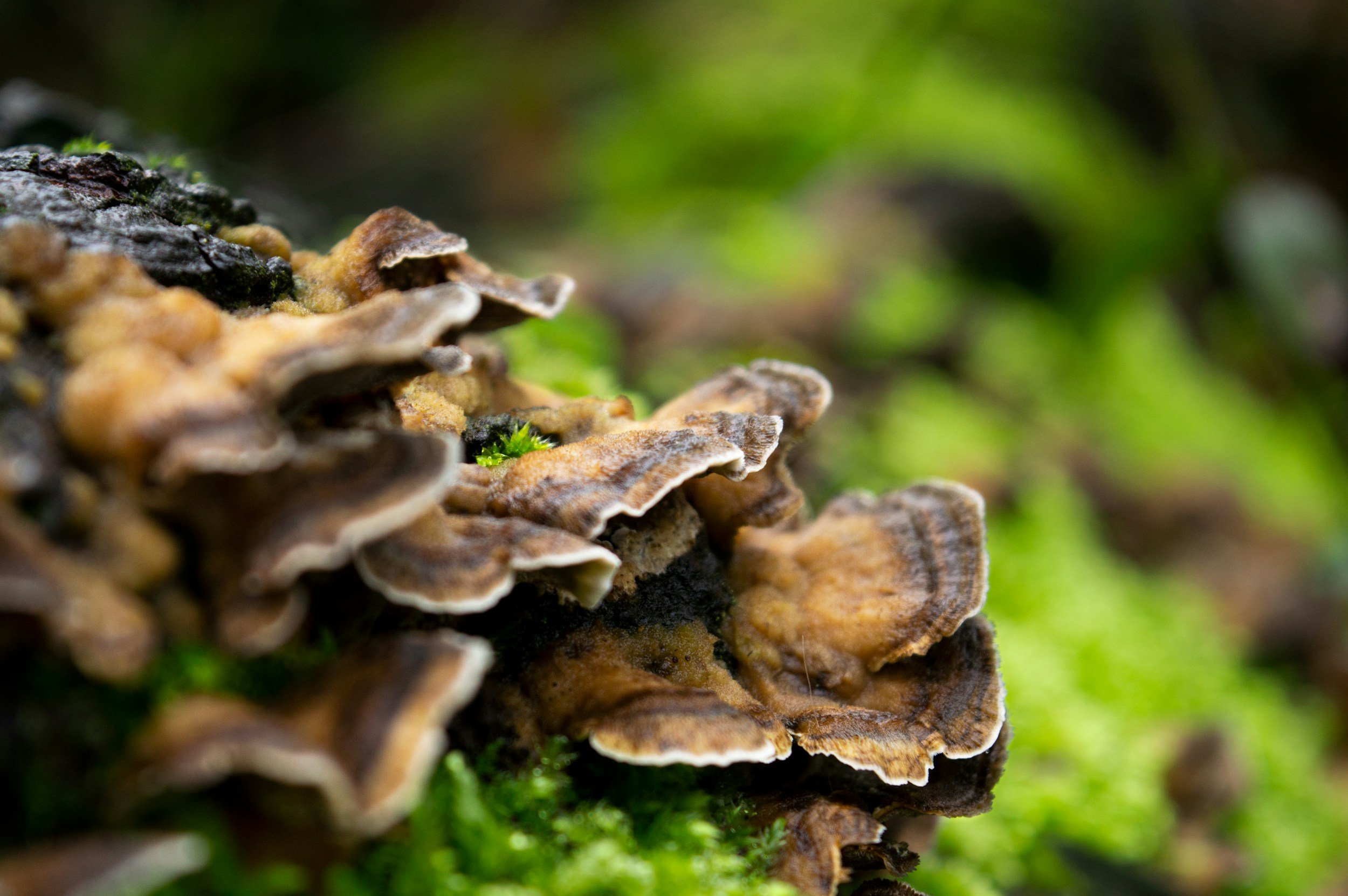

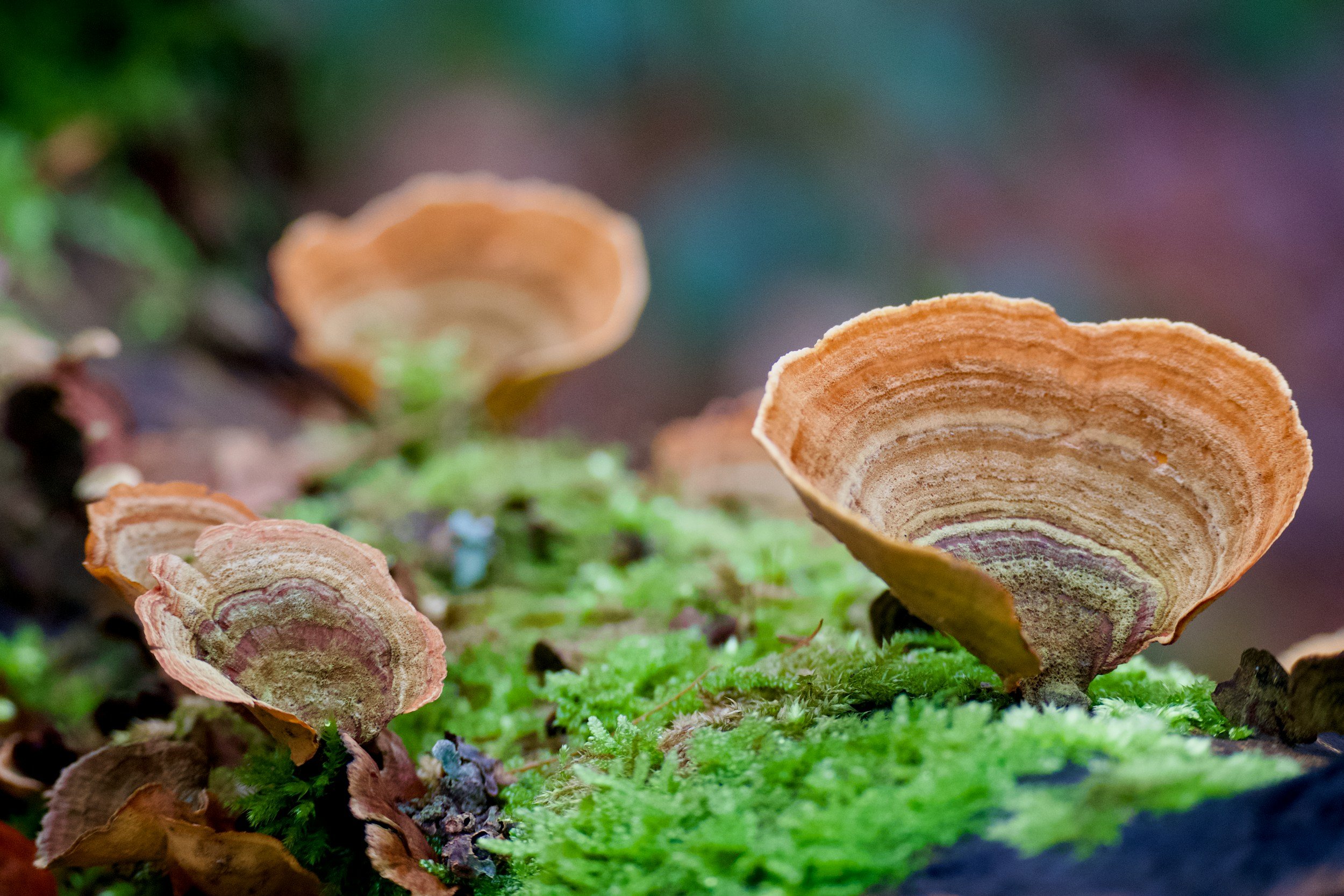
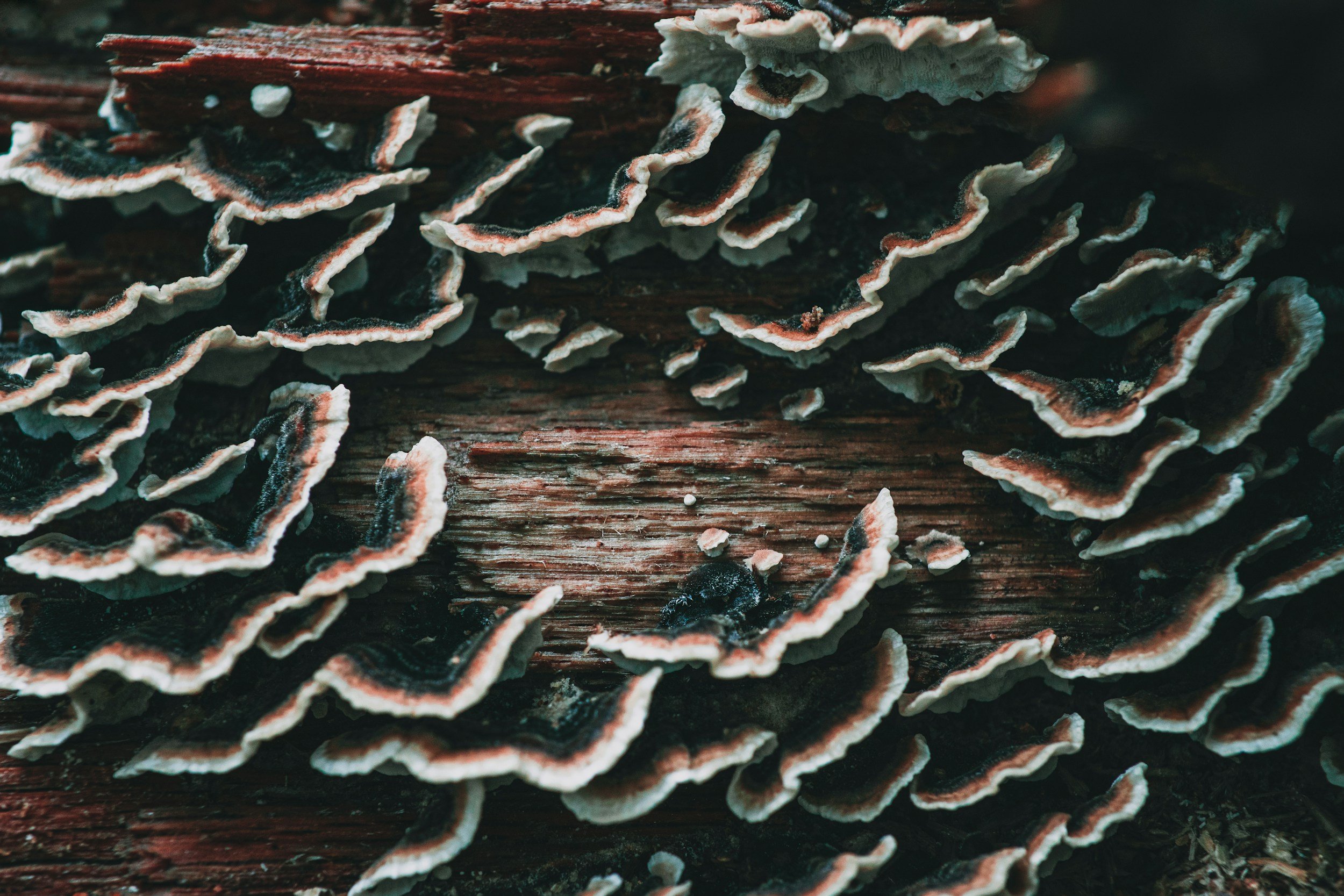
Sources
Advertising Standards Authority. (2024, July 24). Well Gummies (A24-1239904). https://www.asa.org.uk/rulings/well-gummies-a24-1239904-well-gummies.html
Bartram, T. (1998). Bartram’s encyclopedia of herbal medicine. Constable & Robinson.
Barnes, J., Anderson, L. A., & Phillipson, J. D. (2007). Herbal medicines (3rd ed.). Pharmaceutical Press.
Benzie, I. F. F., & Wachtel-Galor, S. (Eds.). (2011). Herbal medicine: Biomolecular and clinical aspects (2nd ed.). CRC Press.
Bergamin, A. (2025, October 9). How can you tell a true turkey tail from an imposter? Bay Nature. https://baynature.org/2013/11/28/ask-the-naturalist/can-tell-true-turkey-tail-imposter/
Buczacki, S., Shields, C., & Ovenden, D. (2013). Collins fungi guide: The most complete field guide to the mushrooms & toadstools of Britain & Ireland. William Collins.
Evans, W. C. (2009). Trease and Evans’ pharmacognosy (16th ed.). Elsevier.
Fisher, C. (2018). Materia medica of western herbs (Rev. ed.). Aeon Books.
Food Standards Agency. (2025, November 19). Novel foods authorisation guidance. https://www.food.gov.uk/business-guidance/regulated-products/novel-foods-guidance
Hedley, C., & Shaw, N. (2019). A herbal book of making and taking. Aeon Books.
Hoffmann, D. (2003). Medical herbalism: The science and practice of herbal medicine. Healing Arts Press.
Index Fungorum Partnership. (n.d.). Trametes versicolor (L.) Lloyd. Retrieved December 15, 2025, from https://www.indexfungorum.org/names/namesrecord.asp?RecordID=281625
McIntyre, A. (2019). The complete herbal tutor (Revised & expanded ed.). Aeon Books.
Mills, S., & Bone, K. (2013). Principles and practice of phytotherapy: Modern herbal medicine (2nd ed.). Churchill Livingstone/Elsevier.
MycoBank. (n.d.). Trametes versicolor (MycoBank No. 65392). Retrieved December 15, 2025, from https://www.mycobank.org/page/Name%20details%20page/65392
Powell, M. (2014). Medicinal mushrooms: A clinical guide (2nd ed.). Mycology Press.
Rogers, R. (2011). The fungal pharmacy: The complete guide to medicinal mushrooms and lichens of North America. North Atlantic Books.
Sharp, J. (2020, December 10). December’s fungi focus: Turkey tails and false turkey tails. Woodlands.co.uk. https://www.woodlands.co.uk/blog/flora-and-fauna/decembers-fungi-focus-turkey-tails-and-false-turkey-tails/
Disclaimer: This page is for educational purposes only. Consult a qualified medical herbalist before using herbs, especially during pregnancy, when trying to conceive, while breastfeeding, for medical conditions, or with children.
Read the full disclaimer → Medical Disclaimer.





